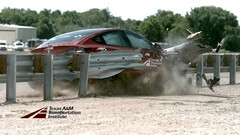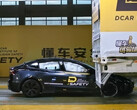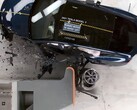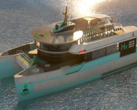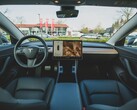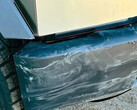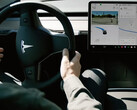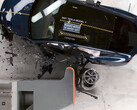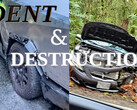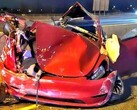The Texas A&M Transportation Institute has done a "Battery Electric Vehicle Crash Test of a Thrie-Beam Guardrail System" using a Tesla Model 3 as a reference vehicle.
The so-called thrie-beam guardrails are manufactured using galvanized steel and are shaped in three corrugation waves, as opposed to the two on the standard W-beam guardrails.
This makes the guardrail stronger and more absorbent of the kinetic energy of cars that careen off the road and hit it.
Unfortunately, even the thrie-beam guardrail couldn't hold the Model 3 under the standard highway safety MASH crash test criteria, i.e. a 25-degree angle impact at a speed of 62 miles per hour.
The Tesla Model 3 simply tore through the guardrail, absorbing the impact through crumpled front, shattered windshield, and deployed airbags.
The Model 3 dimensions categorize it somewhere between a compact sedan like the Toyota Corolla and a mid-sized one like the Nissan Altima. Vehicles in the US have been growing in size and weight since the 80s, but still the compact sedan category now weighs 2,600 pounds on average, while the mid-size sedans are 3,500 pounds.
The tested Model 3, however, weighs north of 4,000 pounds and the current roadside guardrail safety system has only been designed to deal with vehicles up to about 5,000 pounds, so even small electric cars are a challenge to hold.
"Guardrails have been tested extensively with traditional internal combustion engine vehicles, but we don’t yet know how they respond to EVs, which have a lower center of gravity and are generally heavier," says the Manager of TTI’s Roadside Safety Program Roger Bligh.
He added that the Model 3 guardrail crash test results aren't a reason to panic just yet, but rather for more thorough research to devise a plan for roadside safety upgrades.
Guardrails that seemingly can't hold even Tesla's smallest vehicle are found over tens of thousands of miles in dangerous areas along bridges, rivers, ravines, or cliffs.
More crash tests like the one with the Model 3 may be key to determine if and when nationwide guardrail upgrades may be needed, as in the 90s when the old safety system had to undergo design changes to accommodate America's growing demand for larger, heavier vehicles.
The University of Nebraska and the U.S. Army Corps of Engineers’ Research and Development Centre also did guardrail tests with the Rivian R1T and the Model 3 not long ago, with similar results.
"So far, we don’t see good vehicle to guardrail compatibility with electric vehicles," said one of the researchers at the time, and the new TTI crash test with the Model 3 seems to uphold this conclusion.
Get the 80A Tesla Gen 2 Wall Connector with 24' cable on Amazon




